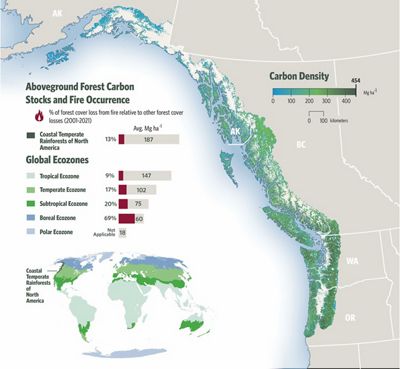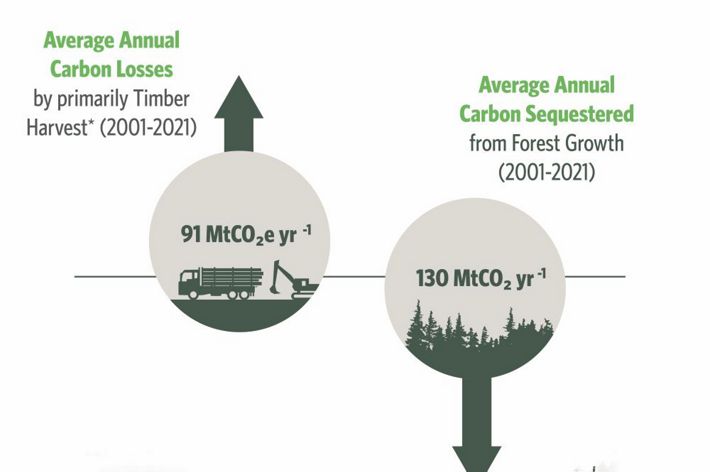Nature Conservancy Releases Innovative Emerald Edge Carbon Map

Media Contacts
-
Emily Heber
Media Relations Manager
Phone: 206-971-4376
Email: emily.heber@tnc.org
The Nature Conservancy (TNC) and our Canadian affiliate Nature United are excited to announce the launch of the Emerald Edge Carbon Map, an innovative, interactive map to help identify the most impactful and actionable opportunities for natural climate solutions projects that also support Indigenous and community priorities. Natural climate solutions are actions to protect, manage and restore ecosystems that help sequester carbon and fight climate change.
The Emerald Edge is the world’s largest coastal temperate rainforest and is a globally important carbon storage and sequestration heavyweight. The region spans 125 million acres across Oregon, Washington state, British Columbia and Alaska, and comprises the territories of more than 50 Indigenous Nations who continue to care for the land to support their cultures, food security, ecotourism services and other economic uses.
Quote: Eric Delvin

The Emerald Edge Carbon Map uses publicly available data to help inform community-based projects by demonstrating their potential to help fight climate change while providing community benefit.
Developed by TNC scientists, the map integrates a suite of forest carbon datasets, land ownership and designation information. It can serve as a tool for decision-makers, land managers and communities to explore carbon storage potential through improved forest management activities (such as deferring timber harvest) that result in more carbon stored within forests and/or reduce greenhouse gas emissions from forestry activities.
“In two decades of working in the Emerald Edge, TNC and Nature United have seen the transformative impact of deep, trust-based partnerships between Indigenous Peoples and local communities and conservation groups, producing lasting benefits for both people and the planet,” said Emerald Edge Program Director Eric Delvin. “The Emerald Edge Carbon Map uses publicly available data to help inform community-based projects by demonstrating their potential to help fight climate change while providing community benefit.”

Paired with the launch of the Carbon Map, the scientific journal Communications Earth and Environment has published TNC’s key findings and methodology. The Carbon Map shows that the entire region sequesters a net total (after accounting for carbon losses) of 186 million metric tons of CO2 out of the atmosphere annually equal to the annual greenhouse gas emissions caused by the energy usage from more than 24 million houses. [1] Detailed in the journal article, our analysis found that 32 million acres (13 million hectares) across the Emerald Edge are potentially available for NCS projects with additional carbon storage. And the analysis demonstrated that a conservative 10% increase in improved forest management and conservation across these lands could contribute an additional 9.1 million tons of CO2e (CO2 equivalent) annually, or 5.2% of the 2030 land-based Paris Agreement commitments made by the United States and Canada combined.
With increased and more widely implemented improved forest management and protection practices, the Emerald Edge can store substantially more carbon, playing a critical role in addressing human-caused climate change. Yet to date, land managers and stewards have lacked precise and regionally consistent mapping information about the amount of carbon housed in these forests and how this carbon relates to the current status of land protection.
"The power of the Carbon Map lies in its potential to equip private landowners, Indigenous Peoples, public agencies and local communities to make informed and data-driven decisions regarding land use and resource management,” said Nature United’s Senior Conservation Scientist Ronnie Drever, a member of the mapping team. “By integrating data on land management designations, ownership and regulatory constraints the Carbon Map reveals climate mitigation opportunities at a scale that is useful for making informed decisions for protecting or storing even more carbon."
The Emerald Edge Carbon Map categorizes lands by their likely ability for forest management changes to help ensure conservation projects would result in more carbon sequestration than would be achieved otherwise. Areas without protections or with management directives that allow active timber harvest (such as industrial timberlands) are generally considered potentially viable for projects that can store more carbon compared to a business-as-usual scenario.
Paired with data in the map that measure annual carbon loss or gain, this information can allow decision-makers to prioritize projects and initiatives that offer significant carbon storage, optimizing the impact of conservation efforts. By considering these factors, we can design policies and incentive programs to influence forest management choices and encourage conservation actions that genuinely contribute to meeting climate mitigation goals.

[1] Calculated using the U.S. Environmental Protection Agency’s greenhouse gas equivalencies calculator
The Nature Conservancy is a global conservation organization dedicated to conserving the lands and waters on which all life depends. Guided by science, we create innovative, on-the-ground solutions to our world’s toughest challenges so that nature and people can thrive together. We are tackling climate change, conserving lands, waters and oceans at an unprecedented scale, providing food and water sustainably and helping make cities more resilient. The Nature Conservancy is working to make a lasting difference around the world in 83 countries and territories (39 by direct conservation impact and 44 through partners) through a collaborative approach that engages local communities, governments, the private sector, and other partners. To learn more, visit nature.org or follow @nature_press on X.
